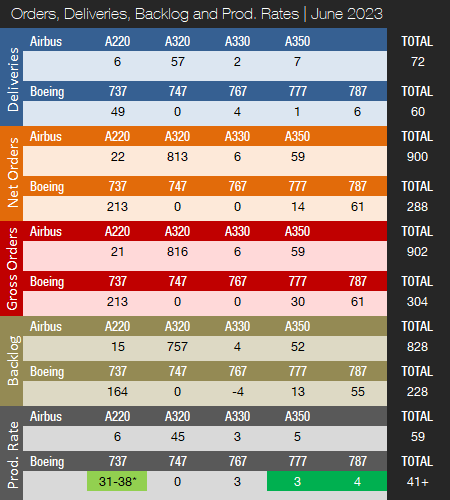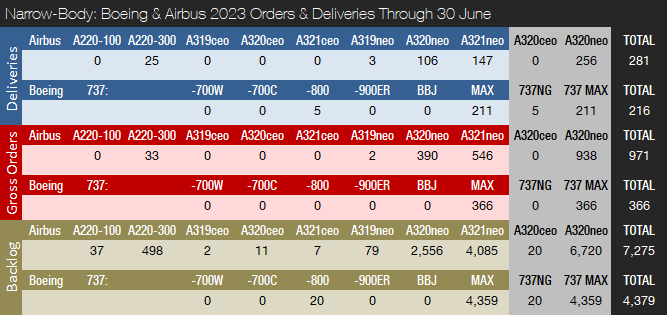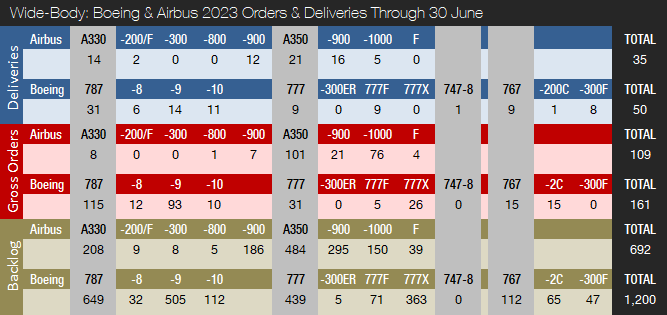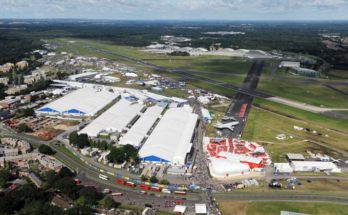Orders surge in Paris for Boeing and Airbus. Airbus sets new all-time backlog record.

Boeing and Airbus delivered 60 and 72 commercial jets in June 2023, compared to 51 and 58 deliveries, respectively, in the same month last year. Year-to-date, Boeing and Airbus have delivered 266 and 316 aircraft, compared to 216 and 295, respectively, for the first half of 2022. After the first six months of the year, Boeing and Airbus are 50 and 21 deliveries ahead of last year’s totals to date. In 2022, Airbus won the deliveries crown for the fourth year in a row by delivering 663 aircraft, compared to Boeing’s 480 shipments. In 2021, Boeing and Airbus delivered 340 and 611 aircraft.
Following a more than challenging 2020 due to the COVID-19 pandemic, 2021 and 2022 were recovery years for the two largest commercial plane makers. Another year of recovery for the commercial aircraft manufacturing industry can be expected in 2023 despite ongoing supply chain challenges, higher interest rates, labor shortages, and the war in Ukraine. However, Boeing and Airbus still have quite a way to go before deliveries are back to pre-pandemic levels. In 2018, before COVID-19 and the 737 MAX grounding, Boeing delivered 806 jets, a level that will likely not be recaptured before the 2025-26 timeframe. Airbus’ all-time record high of 863 shipments was set in 2019, a level that could be surpassed in 2024 if supply chain challenges ease, but most likely not before 2025. Also, Airbus is expected to retain the deliveries lead for the foreseeable future due to the company’s comfortable backlog lead over its American rival. Prior to 2019, Boeing had out-delivered Airbus every year since 2012.
As indicated above, in June 2023, Boeing delivered 60 jets, including 49 737s (48 MAXs and one NG), four 767s, one 777, and six 787s. Since June of last year, the 737 program has been producing aircraft at an official rate of 31 per month. The monthly production trend is expected to remain in the low 30s for now, but will be increased as soon as the supply chain allows. As we await the release of Boeing’s Q2 2023 earnings later this month, Boeing will likely announce a rate hike in the near future. In June, the chief executive of Boeing Commercial Airplanes, Stan Deal, stated, “It’s pretty soon.” For 2023, Boeing targets an average rate of between 33 and 38 737s per month, or 400-450 for the year. Year-to-date, Boeing has delivered 36 737s per month, on average; however, this figure includes aircraft from inventory. Longer term, Boeing expects to increase production to approximately 50 jets per month in the 2025/26 timeframe. This compares to the pre-crash/pre-pandemic rate of 52 737s per month in 2018. Recently, it was reported that the company is planning to boost production to 52 jets per month by January 2025. The company plans to open a fourth 737 MAX production line in Renton in the second half of 2024. Boeing ended the first quarter with 225 737 MAX jets in inventory, down 25 from Q4 2022. Customers in China account for 138 of these aircraft. Boeing expects most of the inventoried jets will be delivered by the end of 2024. Boeing believes that supply chain constraints will remain a significant challenge in 2023. The company is still producing 737 NGs, but only has 20 737-800s remaining in backlog.
On April 14, Boeing announced that a manufacturing issue affecting a significant number of undelivered 737 MAX airplanes, both in production and in storage, had been discovered. Spirit AeroSystems, which produces the 737’s fuselage, reportedly used a non-standard manufacturing process during the installation of two fittings in the rear fuselage. Inspection and rework are currently ongoing and will impact deliveries in the near future. However, Boeing still expects to deliver 450 737 airplanes this year. Of the 225 inventoried 737 MAX airplanes, roughly 75 percent will require fuselage rework. In May and June, 737 MAX deliveries came roaring back and it would appear the situation is fully under control.
In August of last year, deliveries of the Boeing 787 Dreamliner were resumed following a suspension of shipments that lasted nearly 16 months. Boeing had suspended Dreamliner deliveries in May 2021 for the second time in less than a year. The 787 production rate was recently raised to three aircraft per month, up from two. At the end of June, the rate was raised yet again and is now four per month. The 787 rate will return to five per month by the end of 2023 (for a total of 70-80 deliveries for the year), followed by further increases before reaching 10 aircraft per month by 2025/26. Boeing ended the first quarter with 95 Dreamliners in inventory, down five from Q4 2022. Most of these aircraft will be delivered during 2023 and 2024. However, a new production glitch was disclosed in early June but appears to have been resolved, as deliveries continued later in June after a brief halt. The problem involves miniscule gaps in a fitting on the horizontal stabilizer. The fitting was installed at a Boeing production facility in Salt Lake City, Utah.
The 747 program closed down production when the last aircraft was delivered to Atlas Air on January 31. The 767 program is currently producing at a rate of three units per month, a mix of KC-46 tankers (based on the 767-2C) and 767-300 freighters. The 777 program is currently pushing out aircraft at a rate of three aircraft per month – recently raised from two per month. Most aircraft in backlog are 777 freighters, with only five 777-300ERs left. The 777 program was expected to get a new addition in late 2023 with the first delivery of the 777X, but in April of last year Boeing announced this will now not happen before 2025. This reflects an updated assessment of the time required to meet certification requirements. Last year, Boeing launched a new 777X-based freighter, thereby expanding its 777X and cargo portfolio. By the 2025/26 timeframe, Boeing expects to be delivering four 777s per month.
In June 2023, Airbus delivered 72 jets, including six A220s, 57 A320s (all NEO), two A330s, and seven A350s. The official A320 production rate is 45 aircraft per month and has remained at this level since the end of 2021. On average, the company has delivered 43 A320s per month in 2023 (the 2022 average was also 43). Production is currently being increased and an official raise could be made official later this month at Airbus’ Q2 2023 earnings call. The A320 program is expected to reach a monthly rate of 65 by late 2024 (pushed back twice now due to supply chain challenges). Also, Airbus is working with its supply chain to increase A320 production to 75 aircraft per month in 2026. Airbus also plans to add a second A320 final assembly line in Tianjin, China. The A321XLR flight test program is reportedly progressing well, and entry into service is expected to take place in the second quarter of 2024.
The A220, meanwhile, is being produced at a rate of six aircraft per month, with a monthly production rate of 14 expected by 2025. The A350 production rate currently averages five per month and was expected to be increased to six by early 2023. However, the rate increase is likely to be pushed back to late 2023. Airbus expects to produce nine A350s per month by 2025. The A330 production rate was increased from two aircraft per month to three at the end of 2022, with an increase to four per month expected in 2024.
Turning to the June orders review, Boeing had a banner month thanks to the Paris Air Show and booked orders from nine customers for a total of 304 jets (gross orders). However, the company also reported 16 777X cancellations, resulting in 288 net new orders. The June orders haul was dominated by the massive Air India order announced in Paris for 190 737 MAXs, 10 777Xs, and 20 787-9s. Also, Riyadh Air ordered as many as 39 787-9s, followed by Emirates with an order for 16 777Xs (likely a conversion to a different 777X variant, as 16 777Xs were also debooked this month). The remaining June orders include a total of 23 737 MAXs, four 777Fs, and two 787-9s. Year-to-date, Boeing has accumulated 415 net new orders (527 gross orders), compared to 186 net new orders (286 gross orders) in the first six months of last year. In 2022, Boeing booked 774 net new orders (935 gross orders), up from 479 net new orders (909 gross orders) in 2021 (before ASC 606 changes). Please note that for comparison reasons, we do not include Boeing’s so-called ASC 606 accounting adjustments in the numbers reported in this article and regard net new orders as gross orders minus cancellations.

In June, Airbus had a fantastic month in Paris and booked orders for a whopping 902 aircraft for 12 different customers and reported two A321neo cancellations, for a total of 900 net new orders. The largest order was placed by IndiGo, a major low-cost carrier and India’s largest airline by market share. IndiGo placed a firm order for 500 A320 family aircraft, setting a new record for the largest aircraft order by numbers in the history of commercial aviation. Since its inception, IndiGo has ordered a total of 1,330 Airbus A320 family jets, cementing its position as the largest A320 customer. The New Delhi-based carrier today operates a fleet of around 300 aircraft and is among the fastest growing airlines in the world. The 500 aircraft are expected to be delivered in the 2030-2035 timeframe. Prior to the IndiGo order, the largest-ever order was placed by American Airlines in 2011, when it ordered a total of 460 Airbus and Boeing jets. Also, Air India placed a massive order for 140 A320neos, 70 A321neos, 34 A350-1000s, and six A350-900s. Saudi Arabia’s Flynas ordered 30 A320neos, with other carriers accounting for a total of 21 A220-300s, 16 A320neos, 10 A350-900s, nine A350-1000s, and six A330-900s. Year-to-date, Airbus has accumulated 1,044 net new orders (1,080 gross orders), compared to 259 net new orders (442 gross orders) in the first half of 2022. In 2022, Airbus booked 820 net new orders (1,078 gross orders), surpassing both 2021 gross orders and net new orders. In 2022, Airbus won the orders crown for the fourth consecutive year by a fairly slim margin of just 46 aircraft compared to Boeing. In 2021, Airbus booked a total of 771 gross orders and received 264 cancellations, for a total of 507 net new orders.
At the end of June, Airbus set a new all-time backlog record of 7,967 jets, of which 7,275, or 91 percent, were A220 and A320ceo/neo family narrowbodies. As we reported in our recent Paris recap article, “Airbus could soon announce a new all-time backlog record of some 7,900 jets,” and thereby surpass its old record of 7,725 aircraft set in January 2020. By the end of last month, Boeing’s backlog (total unfilled orders before ASC 606 adjustment) was 5,579 aircraft, of which 4,379, or 78 percent, were 737 NG/MAX narrowbody jets. Boeing’s all-time backlog high of 5,964 aircraft was set in August 2018. The number of Airbus aircraft to be built and delivered represents 9.2 years of shipments at the 2019 production level (the pre-pandemic level), or 12.0 years based on the 2022 total. In comparison, Boeing’s backlog would “only” last 6.9 years at the 2018 level (the most recent “normal” year for Boeing), or 11.6 years based on 2022 deliveries. As of June 30, Boeing’s book-to-bill ratio this year, calculated as net new orders divided by deliveries, is 1.56, compared to Airbus at 3.30. This means that Airbus has received more than three orders for every aircraft the company has delivered so far this year. In 2022, Boeing’s book-to-bill ratio was a very strong 1.61. Meanwhile, Airbus’ book-to-bill ratio was a solid 1.24.
2023 Forecast
Forecast International’s Platinum Forecast System is a breakthrough in forecasting technology that provides 15-year production forecasts. The author has used the Platinum Forecast System to retrieve the latest delivery forecast data from the Civil Aircraft Forecast product. For 2023, Forecast International’s analysts currently expect Boeing and Airbus to deliver 520 and 710 commercial jets, respectively. Please note that these figures exclude militarized variants of commercial platforms such as Boeing’s P-8 Poseidon maritime patrol aircraft and KC-46 Pegasus tanker and Airbus’ A330 MRTT tanker.
Boeing will release Q2 2023 results on July 26. At Boeing’s Q1 2023 investor call, the company reaffirmed its 2023 737 MAX and 787 guidance from November of last year. On the investor earnings call, CEO David Calhoun stated, “We still expect to deliver 450 737 airplanes this year.” In November of last year, Boeing announced that it expects to deliver 400-450 737s and 70-80 787s in 2023, which equates to a monthly average of 33-38 for the 737. Meanwhile, Airbus is targeting 720 commercial jet deliveries in 2023. The company reported its first quarter 2023 results in May and reaffirmed its guidance and will report H1 and Q2 2023 earnings on July 26 (same day as Boeing).

*Boeing is currently transitioning from 31 to 38 737 MAXs per month. The official rate is still 31/mo.




References:
- https://www.forecastinternational.com/platinum.cfm
- http://www.boeing.com/commercial/#/orders-deliveries
- https://investors.boeing.com/investors/fact-sheets/default.aspx
- https://www.airbus.com/aircraft/market/orders-deliveries.html
- https://flightplan.forecastinternational.com/2023/06/23/record-breaking-orders-unveiled-at-2023-paris-air-show-commercial-aircraft-orders-recap/
- https://boeing.mediaroom.com/2023-07-05-Boeing-to-Release-Second-Quarter-Results-on-July-26
- https://www.flightglobal.com/airframers/boeing-closes-on-next-production-rate-rise-for-737-programme/153762.article
Kasper Oestergaard is an expert in aerospace & defense market intelligence, fuel efficiency in civil aviation, defense spending and defense programs. Mr. Oestergaard has a Master's Degree in Finance and International Business from the Aarhus School of Business - Aarhus University in Denmark. He has written four aerospace & defense market intelligence books as well as numerous articles and white papers about European aerospace & defense topics.



